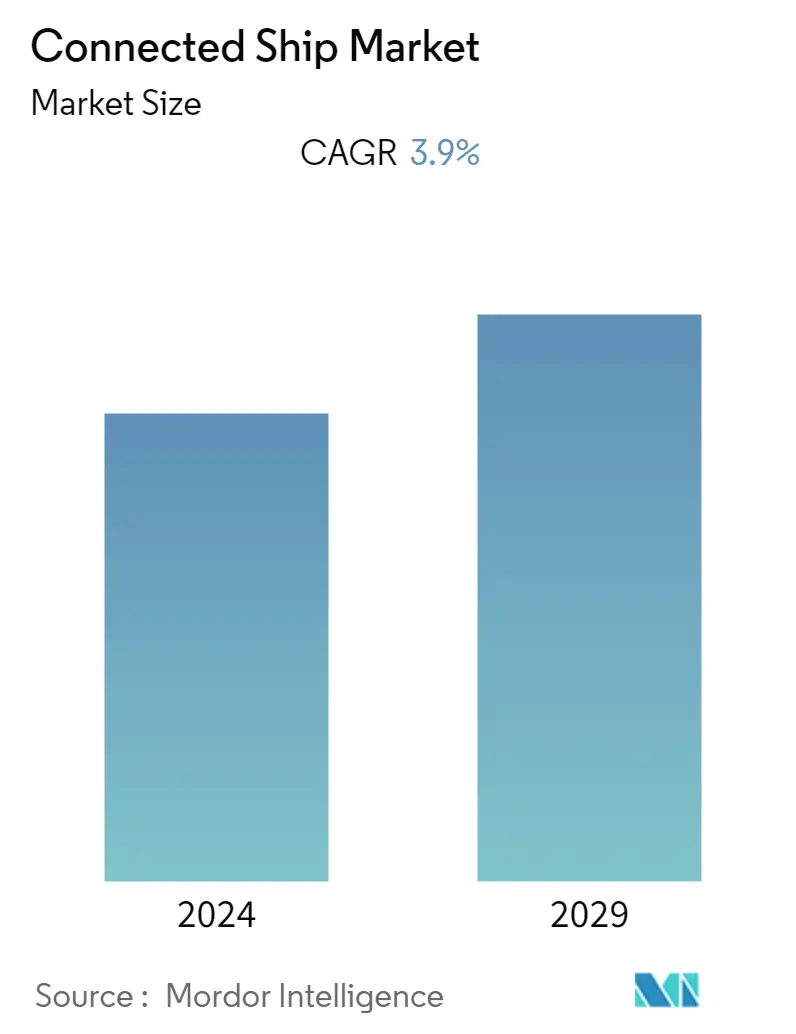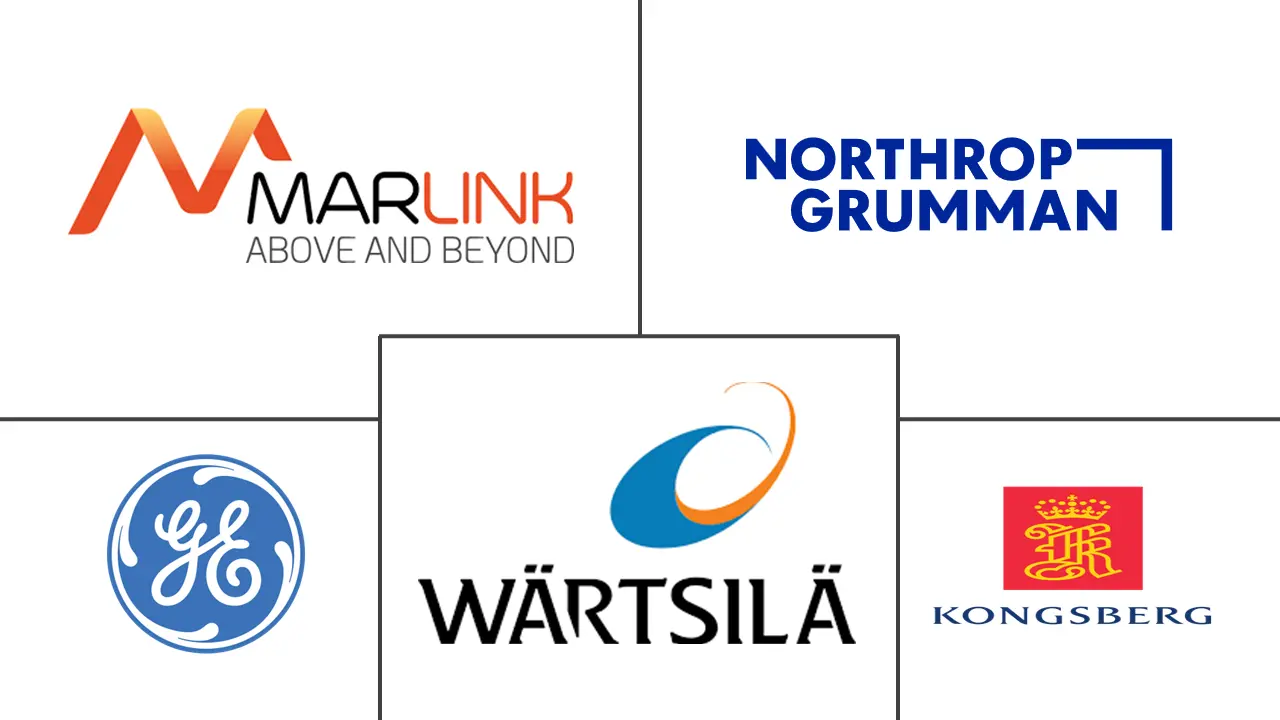Market Size of Connected Ship Industry

| Study Period | 2019 - 2029 |
| Base Year For Estimation | 2023 |
| CAGR | 3.90 % |
| Fastest Growing Market | Asia Pacific |
| Largest Market | Europe |
| Market Concentration | High |
Major Players
*Disclaimer: Major Players sorted in no particular order |
Connected Ship Market Analysis
The Connected Ship Market is anticipated to witness a CAGR of 3.9% over the forecast period. The connected ship technology is installed in commercial and defense cargo ships. It is traditionally used to transfer cargo to seagoing vessels that are either underway or stationary.
- Inline fit or retrofit are different types of installation for deploying connected ship technology. Several applications of this technology include vessel traffic management, fleet operations, fleet health operations, and others.
- Connected ships are being used to transport and trade food, technology, and medicine. Growth and sustainable development depend heavily on affordable and effective transportation, ship traffic management, fleet operations, and fleet health operations to encourage the creation and nurturing of regional value chains all around the globe.
- The increasing seaborne trade across the globe, growing incorporation of ICT in the global marine industry, increasing maritime tourism industry, and augmented budgets of shipping companies for the adoption of digitalization of vessels are some of the significant factors influencing the growth of the market for the connected ship. In contrast, the high deployment cost of marine broadband connectivity is expected to hinder the development of the market.
- The connected ship technology is installed in commercial and defense cargo ships. It is traditionally used to transfer cargo to seagoing vessels that are either underway or stationary. The users of connected ship solutions gather data to have safety at sea, improve productivity, and ensure efficiency in marine operations. This solution offers vessel traffic management, fleet operations, fleet health monitoring, etc.
- With ship traffic increasing worldwide, it has become essential to improve safety and security and safeguard the environment. However, owing to the pandemic, cargo traffic decreased. For Instance, India's Major ports during April-November, 2020-21, decreased by 10.7% to 414.20 million tonnes from 463.73 million tonnes of cargo handled during April-November, 2019-20, according to Shipmin.gov.in.
Connected Ship Industry Segmentation
The connected ship technology is installed in commercial and defense cargo ships and is traditionally used for transferring the cargo to the seagoing ships that are situated either underway or stationary.
The connected ship market is segmented by Ship Type (Commercial, Defense), by Application Type (Vessel Traffic Management, Fleet Operations, Fleet Health Monitoring), by Fit (Line Fit, Retrofit), and Geography.
| By Ship Type | |
| Commercial | |
| Defense |
| By Application | |
| Vessel Traffic Management | |
| Fleet Operations | |
| Fleet Health Monitoring |
| By Fit | |
| Line Fit | |
| Retrofit |
| By Geography | |||||||
| |||||||
| |||||||
| |||||||
| Rest of the World |
Connected Ship Market Size Summary
The Connected Ship Market is poised for steady growth, driven by the increasing integration of information and communication technology within the global marine industry. This technology, utilized in both commercial and defense cargo ships, enhances operations such as vessel traffic management, fleet operations, and health monitoring. The market's expansion is supported by the rising demand for efficient and sustainable transportation solutions, which are crucial for fostering regional value chains worldwide. However, the high costs associated with deploying marine broadband connectivity pose a challenge to market growth. The maritime industry's shift towards digitization and innovation is transforming traditional practices, with connected ships playing a pivotal role in improving safety, productivity, and environmental sustainability.
Europe is expected to be a significant contributor to the connected ship market, with countries like Germany, France, and Italy leading in shipbuilding and marine electronic equipment consumption. The region's focus on autonomous ships and cruises, along with strategic investments in zero-emission vessels, positions it favorably in the international market. Initiatives in Denmark and the UK, such as enhancing IT security and developing autonomous systems, further underscore the region's potential. The competitive landscape of the market is dominated by European players, with major companies like Northrop Grumman, General Electric, and Wärtsilä focusing on expanding their global presence through strategic collaborations. These developments highlight the dynamic nature of the connected ship market and its critical role in the future of maritime operations.
Connected Ship Market Size - Table of Contents
-
1. MARKET DYNAMICS
-
1.1 Market Overview
-
1.2 Market Drivers
-
1.2.1 Increasing Seaborne Trade Across the Globe
-
1.2.2 Growing Incorporation of ICT in the Global Marine Industry
-
1.2.3 Increasing Maritime Tourism Industry
-
-
1.3 Market Restraints
-
1.3.1 High Deployment Cost of Marine Broadband Connectivity
-
-
1.4 Value Chain Analysis
-
1.5 Industry Attractiveness - Porter's Five Force Analysis
-
1.5.1 Threat of New Entrants
-
1.5.2 Bargaining Power of Buyers/Consumers
-
1.5.3 Bargaining Power of Suppliers
-
1.5.4 Threat of Substitute Products
-
1.5.5 Intensity of Competitive Rivalry
-
-
-
2. MARKET SEGMENTATION
-
2.1 By Ship Type
-
2.1.1 Commercial
-
2.1.2 Defense
-
-
2.2 By Application
-
2.2.1 Vessel Traffic Management
-
2.2.2 Fleet Operations
-
2.2.3 Fleet Health Monitoring
-
-
2.3 By Fit
-
2.3.1 Line Fit
-
2.3.2 Retrofit
-
-
2.4 By Geography
-
2.4.1 North America
-
2.4.1.1 United States
-
2.4.1.2 Canada
-
-
2.4.2 Europe
-
2.4.2.1 United Kingdom
-
2.4.2.2 Germany
-
2.4.2.3 France
-
2.4.2.4 Rest of Europe
-
-
2.4.3 Asia Pacific
-
2.4.3.1 China
-
2.4.3.2 Japan
-
2.4.3.3 India
-
2.4.3.4 South Korea
-
2.4.3.5 Rest of Asia-Pacific
-
-
2.4.4 Rest of the World
-
-
Connected Ship Market Size FAQs
What is the current Connected Ship Market size?
The Connected Ship Market is projected to register a CAGR of 3.9% during the forecast period (2024-2029)
Who are the key players in Connected Ship Market?
Northrop Grumman Corporation, Wärtsilä Corporation, Kongsberg Gruppen AS, Marlink AS and General Electric Co. are the major companies operating in the Connected Ship Market.

